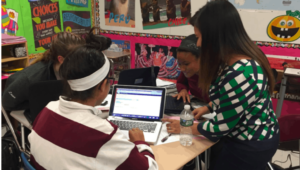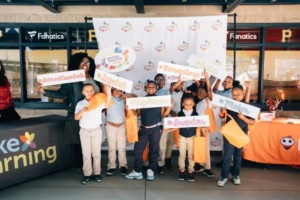A Kentucky Blend
 This morning I met with Kentucky Commissioner Terry Holliday and the State Board. They were the first state to adopt the Common Core and will shift to online assessments ahead of the PARCC timeline. In his own words, you can read about Holliday’s leadership promoting great educators, productivity, and digital learning.
This morning I met with Kentucky Commissioner Terry Holliday and the State Board. They were the first state to adopt the Common Core and will shift to online assessments ahead of the PARCC timeline. In his own words, you can read about Holliday’s leadership promoting great educators, productivity, and digital learning.
Holliday’s Unbridled Learning agenda, substantially captured in SB1, incorporates his standards, assessment and accountability agenda and is supported by some Stupski-funded next-gen pilots. Holliday has the good fortune to work with a lot of talented superintendents like Tommy Floyd in Madison County (featured in this blog).
With Kentucky Virtual, the state was an early leader in providing virtual learning options. But now, through intra-district arrangements, Jefferson County eSchool and Barren Bavel Academy serve far more students statewide. In keeping with Digital Learning Now recommendations, I’ve been recommending that the state shift from provider to authorizer and invite more providers to expand student options.
Like other states, the Kentucky board is beginning to think about how encourage quality digital learning. I warned against simply turning a textbook committee into a digital content committee. Instead, I encouraged them to focus on district and provider results. Districts should be held accountable for results (the state board also discussed their NCLB waiver request at this meeting). Online learning providers should be authorized to offer full- and part-time services statewide after a full program review, including content, instruction, support services, and results (and that should be true of a local option like eSchool or a national provider like K12 or Connections).
When a board member asked about the divide in student access, innovation officer David Cook told board they could expect to see some saving by shifting from print to digital particularly if the state took advantage of open education resources.
Kentucky has equalized funding provided based on daily attendance so there is some incentive to retain students (as opposed to the Colorado push-out incentive produced by funding based on opening enrollment). We recommended that they go a step further and set aside 5-10% for completion and achievement bonuses (for all students, not just online).
Perhaps the most controversial recommendation in the OpenEd produced report released today is fractional and portable funding. Right now, districts control student options so they vary between districts. The report encourages funding that follows the student to the best option.
In conclusion, here’s a little random Kentucky trivia:
- Eisenhower-era architecture did this country no favors as evidenced by the big capital tower erected in Frankfurt, a charming little river town between Louisville and Lexington.
- I spent a couple years in the coalfields of eastern Kentucky as a young mining engineer (after tours in CO, PA, and WV)
- Yes, you can get an MBA with an emphasis in horses
- Yes, UK is ranked #1 in basketball (again)
Blended White Paper. On the subject of blended learning, Envisions, a small San Francisco high school network, ran a quick blended math pilot project this summer using Khan Academy as the primary delivery mechanism. They recently published Lessons from a Blended Learning Pilot. Over the quick pilot, the academic results weren’t striking but I thought their observations about students and teachers was interesting. On the role of the teacher:
We saw the role of the teacher in a blended learning environment involve four key elements 1) fostering a class culture of hard work and persistence, 2) monitoring students through the period for motivation and learning, 3) personalizing instruction and intervening when data shows that students are struggling, and 4) building personal relationships of trust and caring.
These elements are all key to the traditional classroom but they found that teachers spent a larger portion of their time on these roles in the blended classroom. Regarding students, they saw:
strong potential for the blended learning model to: 1) increase student buy-in, 2) increase student ownership of class, 3) make learning more personalized, and 4) increase collaboration amongst peers.
Looks like Envisions is just one of about 30 sites piloting Khan blends. It’s interesting to note that our friends at MIND Research are supporting 1200 blended K-8 sites with terrific results (as measured by randomized controlled trials).
I’m planning to visit the Google Chromebook and apps team in a couple weeks. Let me know how Google is fitting into your blended learning plans and what else you’d like to see.
For more on KY, see KY Board Hears Draft of Ambitious Digital Learning Plan





Paul leather
Thanks for this report. Extremely helpful to those of us seeking to transform Public Ed at the state level. Terry Holiday is a rock star among chiefs today, we are all following his work and vision...